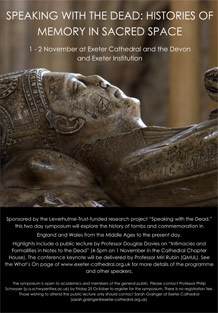
Tomb of Bishop Lacy
Speaking with the dead: All Souls Day
The Day of the Dead, also known as All Souls Day, is about commemoration. This practice of honouring and remembering the dead is observed in churches on 2 November.
As part of a research project, University of Exeter academics are exploring the history of tombs and commemoration in England and Wales from the Middle Ages to the present day.
Exeter Cathedral has numerous tales of morbid fascination, from burial sites to gruesome looking tombs and wax figurines found hidden in its stonework. The ‘Speaking with the Dead’ Leverhulme Trust and European Research Council funded research, focuses on the sacred places where people go to remember and to speak to the dead.
Five hundred years ago, the Cathedral Green was the main graveyard to receive the city’s dead. No other gravestones from this period are to be found anywhere else in Exeter. Archaeologists have identified layers upon layers of burials which took place over almost a millennium. As a result, the remains of tens of thousands of corpses lie under the Green where people now walk and picnic.
Inside Exeter Cathedral ugly skeletal tombs, known ascadaver- or transi-tombs date back to 1400’s can be found, depicting rotting corpses. These rather macabre tombs were fashionable in the late Middle Ages, giving out a strong message about life and the afterlife. English lecturer Dr Naomi Howell explains:“The intention of the deceased, who would have come from a wealthy family, was for worshippers of the parish to consider their own fate. The ghoulish tomb was intended to make them think about the transience of life. Inscribed on one of these Exeter tombs: ‘As you are so I once was, as I am so you will be’. As if to say: Don’t put your trust in earthly beauty or riches: be good whilst alive so your soul may enter paradise as your body returns to the earth in death.
The concern by the Christian faith about idol worshipping is also apparent in the various headless figures and defaced busts found in religious places of worship across the UK, including Exeter. University of Exeter, Professor Philip Schwyzer said:“The reformers who smashed up so-called ‘idols’ didn’t want to destroy them completely. They wanted to leave something left over, something ugly and broken, so later generations would remember what they had done. They made the cathedral into a memorial to their own destructive rage.”
The intriguing tale of the wax figurines found in Exeter Cathedral during the war, offered Dr Howell further insight into the way people use tombs as a means of maintaining a link between the living and the dead. She said: “In Medieval England, people would pray to saints requesting healing, this often manifested itself in leaving offerings beside saint’s relics. As Exeter doesn’t have any relics, it is thought that worshipers focused on the tomb of Bishop Lacy who was alleged to be saint-like. It is here that doll-sized hands, feet, ears and arms were created from wax and placed on his tomb as part of a prayer to heal that particular area of the body.”
A collection of the wax figurines were found after routine checks for bomb damage was carried out in the Cathedral in the 1940’s. The wax figures were found hidden in the stonework above the tomb, where they had remained hidden for centuries. It is likely that they were secretly tucked away at the time of the Reformation, when acts of idolatry were condemned.
Dr Howell added:“The miniature wax body parts are a unique find. Nothing else like this exists, as it is likely that they would have been destroyed by church authorities, who considered the figurines dating back to pagan rituals and therefore frowned upon. Wax was an expensive commodity at the time, so it is also possible that the figurines were reused as candles. What it says about people at the time is that they used objects as a way of speaking with the dead and such rituals continue today in the form of flowers, cards and other offerings to the dead, which can be seen in the Lady Chapel of the cathedral, and in many other places, including places of political or personal importance, and of natural beauty.”
A two day conference on 1 -2 November at Exeter Cathedral will explore the history of tombs and commemoration in England and Wales from the Middle Ages to the present day. The research event is free of charge, open to academics and members of the public with admittance to the event by advance registration.
Date: 28 October 2013
